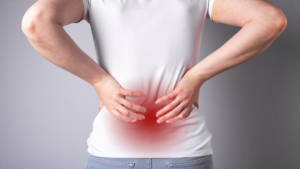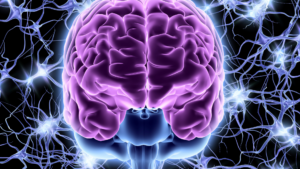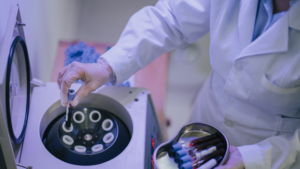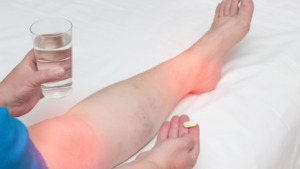Chronic pain affects millions of Americans each year. Back pain is not only uncomfortable, but it can be debilitating and cause damage to other parts of the body. Living with back pain interferes with the quality of life on a regular basis and can be incredibly limiting.
Back pain can be acute or chronic, and many factors determine the kind of pain you experience. Because the back is such a complex structure, conditions vary from short-term wear-and-tear relief using over-the-counter medications to degenerative conditions treated by invasive surgeries.

Treating Chronic Back Pain
Treating Chronic Back Pain
In many cases, chronic back pain is treated through the use of minimally invasive procedures and joint injections. Many physicians use fluoroscopic guidance to perform these types of treatments. This allows them to see the affected area on a display screen and precisely place the needle. Fluoroscopy guidance helps prevent surgery, since is allows minimally invasive techniques to be performed with the greatest accuracy.
Your individual symptoms, the source of pain, and need will determine the best treatment method. Many minimally invasive procedures and joint injections work to reduce pain.
Joint Injections and Treatment Options
Epidural Steroid Injections
This injection is used to reduce inflammation in the spinal column that causes pain and nerve irritation. An anti-inflammatory medication is injected into the epidural space in the spine. These injections are a good option for patients with spinal stenosis, herniated discs, and degenerative disc disease. Patients typically find their relief starts within a week of receiving the treatment and it lasts anywhere from a few days to a few months.
Facet Joint Injections
Facet joints are the small joints that allow your back to bend, twist, and move. When they become inflamed or injured, they can cause immense pain. This procedure injects a steroid and anesthetic medication into the joint. It can be very effective for patients who have suffered cartilage damage or back injuries from twisting. Pain relief may last weeks or months.
Trigger Point Injections
Trigger points are small muscle cramps within the body of a muscle that are extremely tender. Trigger points refer pain to other areas of the body. These injections administer a numbing agent to the trigger point, allowing it to relax and reduce pain. Trig point injections may be helpful if you experience back pain when pressure is applied in a specific area.
Sacroiliac Joint Block Injection
The SI joint connects the lower back of the spine to the pelvis. When the joints become inflamed and painful, movement can be affected and tasks such as sitting and walking. This injection consists of both an anti-inflammatory steroid and numbing agent. It is injected directly into the sacroiliac joint to relieve pain as effectively as possible.
Expected Results After Joint Injections
Joint injections are an outpatient procedure, and many times, they can be performed in your pain specialists’ office. Patients normally resume walking after the procedure, but need to have someone drive them home after receiving treatments. This is because doctors will administer a low-dose local anesthetic to numb the affected area before treatments.
Is is common for pain to continue a few days after the treatments, especially as the numbing agent wears off before the medication takes effect.
Pain relief generally starts two to seven days after the injection and can be reduced for several months. Your physician will often refer you to a physical therapist so you can exercise and strengthen your joints during this time of reduced or eliminated pain.
If injections prove to be helpful, the procedure can be repeated approximately 3 times a year. Other treatment options are available when joint injections do not reduce your pain. Keep track of your pain levels and communicate clearly with your doctor to create the best-suited treatment plan for your individual back pain.
The team of professionals at Progressive Pain Management are here to help. Fill out the form below to get started.
Fibromyalgia is a common chronic pain syndrome that affects 4% of people in the United States. This pain is typically characterized by widespread chronic pain, fatigue, and tenderness to the touch.
This syndrome affects ligaments and muscles and is usually present for many years by the time a medical professional diagnoses it. Fibromyalgia has been proven to be genetic, although symptoms appear most frequently after a stressful event – whether emotional, physical, or medical. Chronic pain due to health conditions like systemic lupus or rheumatoid arthritis can trigger fibromyalgia syndrome.
Even a gentle massage can be extremely painful for patients who suffer from fibromyalgia. This is because their muscles are tender to the touch. This often disrupts daily life and prevents people from retaining a high quality of life.

How to Treat Fibromyalgia
Symptoms often include
- Stress – mental and psychological
- Illness
- Depression
- Lack of concentration
- Headaches
- Fatigue
Ways to Treat Fibromyalgia Pain
Over-the-Counter Medications
Your doctor may recommend over-the-counter medications to relieve pain from fibromyalgia. Pain relievers such as aspirin, ibuprofen, and naproxen may be used to help minimize muscle aches, reduce inflammation, and improve sleep.
Always check with your doctors before taking NSAIDs. If taken over a long period of time, they increase the risk of strokes, heart disease, and stomach ulcers.
Antidepressants
Antidepressants help with pain and fatigue. They also help raise the levels of naturally produced chemicals such as serotonin and noreinephrine. The side effects of can include nausea and weight gain.
Yoga
Taking yoga classes promotes muscle strength, incorporates meditation, and teaches different ways to relax. Individuals with fibromyalgia who take yoga classes experience a boost in their mood and less pain and fatigue.
Be sure to let your instructor know about your condition so they can adjust poses for you, if necessary.
Acupuncture
Acupuncture for pain relief is proven to help patients who have fibromyalgia. It involved pricking the skin with tiny needles, which is used to promote natural self-healing, encourages blood flow, and a change in the level of neurotransmitters in your brain.
It can be used to treat a variety of chronic pain conditions. Always be sure your acupuncturist is licensed to decrease any risks or side effects.
Physical Therapy
Physical therapy is used to improve your range of motion and strengthen muscles. Therapists design a specific program to help manage specific pain conditions in order to reduce pain. Along with self-care techniques, physical therapy helps manage fatigue and pain on your own.
Exercise
Exercise is a proven way to battle tiredness and increase energy levels. Exercise increases the brain’s production of endorphins, improving sleep and reducing depression. For people with fibromyalgia, activities like walking, biking, and swimming continue to show benefits in improving health.
When fibromyalgia affects your daily life and keeps you from doing waht you love, visit Progressive Pain Management. Their comprehensive and holistic approach to treating pain will help reduce your symptoms while caring for the root cause of pain. Fill out the form below to learn more.
Chronic pain is pain that is ongoing or lasts longer than 6 months. And while this pain can be debilitating and affect your daily life, it can also cause other serious health issues and affect the central nervous system.
How Pain Signals Work in Your Body
Your brain and spinal cord work together to receive pain signals from nerves and muscles, which send patterns of signals to the rest of the body. These signals help the body control leg, arm, and spine movements. These signal patterns develop and allow us to ride bikes, walk, or even play an instrument or knit.
However, when you are experiencing chronic pain, the sensors and nerves that send out pain signals “misfire” and the brain and spinal cord are unable to function properly in accordance with what the signal is trying to communicate. The spinal cord reacts in a way that increases a normally harmless pain signal, creating severe chronic pain.

How Chronic Pain Affects the Central Nervous System
The Relationship Between Pain and the Central Nervous System
When the spinal cord increases the pain signals, your central nervous system understands them as incredibly intense and painful. Even harmless signals are miscommunicated as horrible pain signals. The central nervous system operates differently than a pain-free nervous system and causes the patient to become more sensitive with less provocation. This is referred to as “central sensitization.”
Not only are patients who suffer from central sensitization extremely sensitive to things that should hurt, but ordinary things like a simple touch or slight pressure can be excruciating. Pain that typical patients may describe as a two on a numeric pain scale (1-10 level of pain) may feel like an 8 or a 9 for patients that have central sensitization. The pain becomes extremely amplified, even doing activities such as doing the dishes or walking to the mailbox.
Central Sensitization
Central sensitization is a condition that is associated with the maintenance of chronic pain. During flare ups, the nervous system goes into shock and is in a constant state of high reactivity. Being highly reactive lowers the threshold for the cause of pain and the ability to maintain pain after the injury is healed.
Central Pain Syndrome
Central pain syndrome is a neurological condition. It is caused by a dysfunction that affects the central nervous system, such as multiple sclerosis, Parkinson’s disease, or spinal cord injuries. It can take months or even years after an injury or trauma to affect the CNS.
Similar to central sensitization, central pain syndrome is heightened by light touch. However, the most common symptom is the sensation of burning. Pain increases when the temperature drops, and a loss of sensation may occur.
How Central Sensitization Affects Pain
As peripheral pain signals are transmitted to the spinal cord, there are receptors that determine whether or not the spinal cord should respond. Weak muscle signals can be amplified and misinterpreted as pain. The spinal cord becomes highly irritated and misreads the signals from parts of the body, making them stronger than usual. Patients have even experienced intense pain from the weight of a blanket or bed sheet.
This is the central amplification of a peripheral pain signal. The peripheral and central nervous systems work together to help the body determine how the body reacts to a sensation.
Overtime, chronic pain and misread signals can physically change the way the central nervous system responds to pain. The experts at Progressive Pain Management can help control your chronic pain and reduce symptoms caused by central sensitization.
Fill out the form below to talk to our doctors about chronic pain and symptoms you may be experiencing.
In recent years, research has proven that the body has the unique ability to heal itself. The body can regrow tissue and cells and repair damage to ligaments, muscles, and joints. Through the use of Platelet-Rich Plasma treatments, the body is given a chance to accelerate repair and heal quickly. The effectiveness of PRP is constantly improving thanks to scientific advances and improvements in technology.
What is Platelet-Rich Plasma?
Blood contains components like red and white cells and platelets. The liquid portion of the blood is called plasma and is mostly made up of water and proteins. Its primary function is to help blood cells and platelets move throughout the body. Platelets are special blood cells that cause blood clots, but most importantly, contain growth factors that are crucial for healing injuries.
Platelet-Rich Plasma (PRP) is plasma with significantly more platelets than what is normally found in blood. In fact, the concentration of growth factors can be 5 to 10 times richer than usual.

Platelet-Rich Plasma Therapy
What are PRP Injections?
Platelet-Rich Plasma injections are a concentrated solution of the patient’s own platelets. They use the patient’s individualized healing system to recover injured muscles, tendons, and joints.
How Do PRP Injections Work?
Blood must first be drawn from the patient to prepare for PRP Injections. The blood is then filtered to concentrate the platelets, using a machine called a centrifuge. This platelet-rich plasma is then injected directly to the affected area or diseased tissue. Growth factors are released and increase the number of reparative cells the body produces.
Ultrasound imaging can sometimes be used to guide the injection.
There are two ways PRP Injections can be used:
- Platelet-rich plasma can be injected directly into the injured area. A mixture of PRP and a local anesthetic can be injected into inflamed tissue to help decrease pain, swelling, and accelerate healing. The injection site may be sore for a few days following the procedure and can take several weeks to feel the full effect of the injection.
- Platelet-rich plasma can be used after surgery to aid healing. An athlete with a torn ACL may require surgery to repair the ligament. Healing the ligament can be improved by using PRP during surgery. The PRP is prepared in a very specific way that allows it to be woven into the torn tissues.
Effectiveness of PRP & Conditions They Treat
Studies are constantly being conducted to measure the effectiveness of PRP injections. Results can vary, depending on the area being treated, the overall health of the patient, and the severity of the injury that is being treated.
Some conditions PRP is being used to treat are:
- Chronic Tendon Pain: PRP is very successful in treating tendon injuries such as tennis elbow and Achilles tendonitis.
- Muscle Injuries: Athletes have been using PRP therapies to treat muscle injuries such as a pulled hamstring.
- Surgery: As previously mentioned, PRP is being used in surgery to help heal scar tissue.
- Knee: PRP can be used to help heal the knee after surgeries like an ACL repair or joint replacement. It is also being used to treat osteoporosis in the knee.
There are other uses that are being researched and tested on an ongoing basis to help increase the effectiveness of PRP injections. Fill out the form below to learn more about Platelet-Rich Plasma therapy and how it may help your chronic pain. Someone from the team at Progressive Pain Management will be in touch with you shortly.
Sources:
https://www.ncbi.nlm.nih.gov/pmc/articles/PMC5911760/
https://orthoinfo.aaos.org/en/treatment/platelet-rich-plasma-prp/
https://www.hss.edu/condition-list_prp-injections.asp
Lower extremity pain is commonly due to overuse and inflammation as a result of conditions that affect bones, joints, muscles, tendons, and other organs. The key to pain is understanding what causes it. Only physicians can truly diagnose this kind of pain. There are a few questions to ask when diagnosing pain in your legs, hips, thighs, ankles, and lower joints.
- Is there a recent trauma? Falls to the ground are a common cause for lower extremity pain. This is especially true when a patient is unable to recall periods of time or suffers from a drug withdrawal. There is a chance of fracture, so radiographs should be taken.
- Is the pain articular or non-articular? Articular pain (meaning joint pain) is often accompanied by inflammation or swelling. Non-articular pain is musculoskeletal pain and affects muscles and bones. These differentiating symptoms help physicians diagnose the potential source of the pain.
- What is the root of the pain? When determining and understanding the root of the pain, physicians consider a broad variety of symptoms and characteristics regarding your pain. Things like infection, inflammation, vascular, and neoplastic causes can disguise other sources of pain.

Lower Extremity Pain
Being able to answer those questions helps pain doctors diagnose pain and recommend effective treatments for lower extremities. The term “lower extremities” includes the pelvis and hip joint, thigh, knee, lower leg, ankle, and feet.
Types of Lower Extremity Pain
Ankle
Because your ankle bears the weight of your entire body, it is prone to injury. The ankle is a complex network of bones, tendons, muscles, and ligaments. This means there are a lot of things that can cause pain.
Ankle pain can be caused by a number of conditions, including, but not limited to:
- Achillies tendonitis
- Gout
- Osteoarthritis
- Plantar Fasciitis
- Sprained Ankle
- Stress Fractures
Thigh
Pain in your thigh commonly starts in nerves that surround the hip and radiate down. Muscle pain, nerve pain, and injuries are all factors to consider when looking at thigh pain.
Pain may be caused by:
- Bernhardt-Roth syndrome
- Overuse
- Sciatica
- Peripheral Neuropathy
- Sprained or torn ligament
- Blood clots
Foot
Foot pain can be caused by overuse and conditions that cause inflammation like injury to tendons or ligaments in the foot. Arthritis is a common cause of foot pain. The bottom of the foot has a network of nerves that cause immense burning sensations, numbness, or tingling when damaged.
Common causes of foot pain include:
- Osteoarthritis
- Mortnon’s Neuroma
- Plantar Fasciitis
- Gout
- Diabetic Neuropathy
- Tendonitis
Lower Leg
A wide variety of conditions and injuries can cause leg pain. Generally, the leg pain is a cause of tissue inflammation. This can be a result of injury or chronic diseases. The leg contains many different types of tissues and bone structures, making injury and pain very common.
Leg pain can be caused by:
- Shin Splints
- Stress Fractures
- Diabetic Neuropathy
- Peripheral Artery Disease
- Sciatica
- Deep Vein Thrombosis
Hip and Pelvis
Hip and pelvis pain can be difficult to diagnose. The movement of the hip joint, lower back, and leg bones are all connected by a large network of muscles, ligaments, tendons, and joints. Pain from another area of the body frequently causes pain in the hip and pelvis region. This is called referred pain.
Sources of pain can include:
- Bone Fractures
- Arthritis
- Nerve Damage
- Muscle Injury or Inflammation
Knee Joint
If you use your knees to repetitively kneel or lift heavy objects, you may experience knee pain. Knee pain affects people of all ages. Injuries are common and regularly affect the ligaments, tendons, or fluid-filled sacs surrounding the bone. Cartilage in the knee also gets damaged from normal wear and tear, which can cause pain.
Common causes for pain include:
- Osteoarthritis
- Meniscal Injuries
- Cysts
- Gout
- ACL tears
- Bursitis
Treatment Options
Once a diagnosis has been made, your physician will create a treatment plan specific to your pain. If the cause is musculoskeletal, non-steroidal medications or acetaminophen may be used. If pain persists, stronger medications may be prescribed, although it is rare that narcotics are needed.
If the pain is articular, corticosteroid injections may be used to reduce pain. Muscle and tendon pain can be reduced using physical therapy. However, if the muscle pain is due to arthritis, physical therapy may not be helpful.
Your doctor will work with you to form an effective treatment plan that fits your lifestyle and provides the greatest success in restoring a higher quality of life. Fill out the form below to get in touch with the team at Progressive Pain Management.

